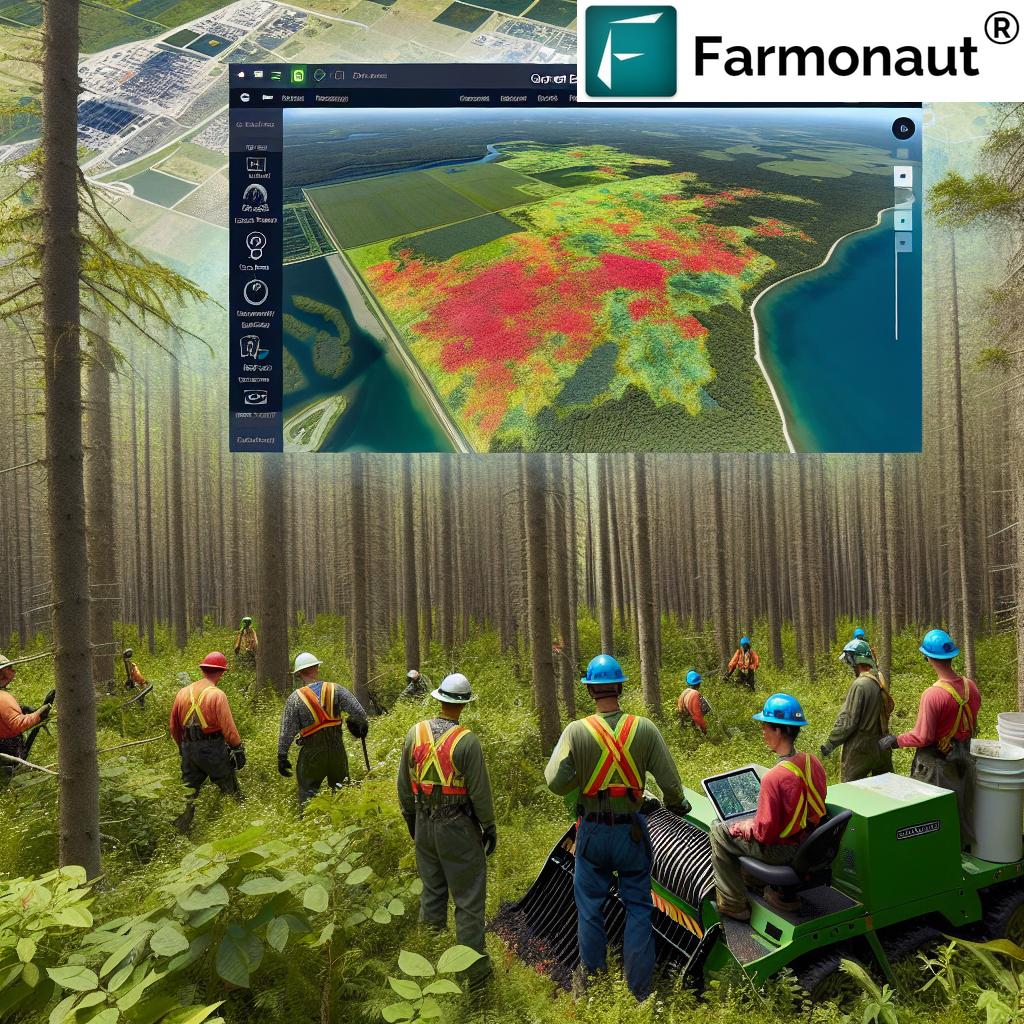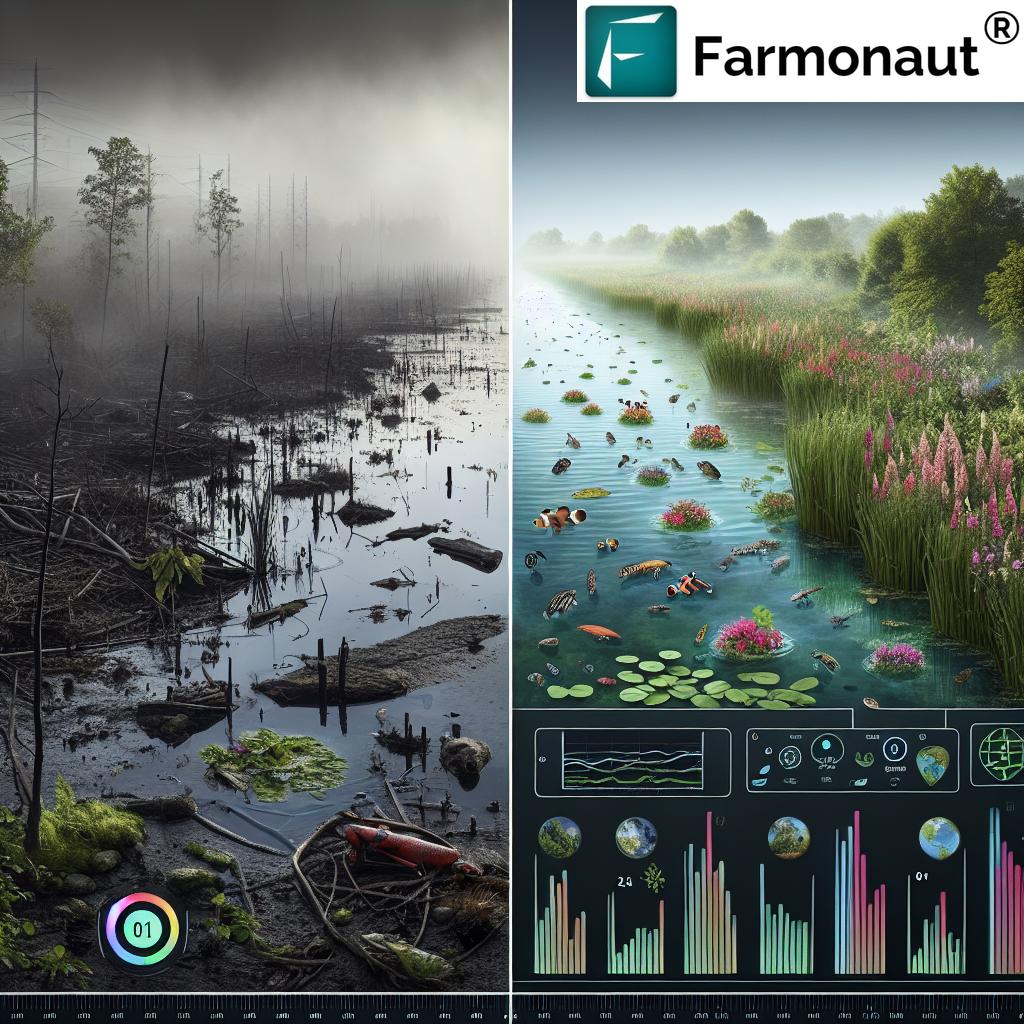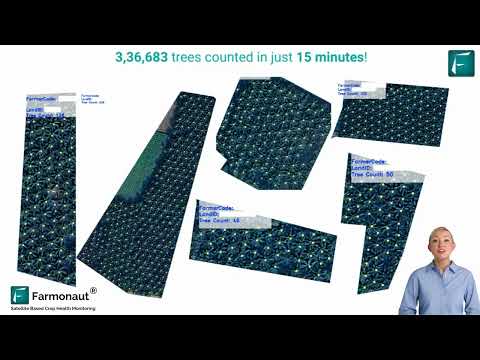Discover Farmonaut’s Advanced Solutions for Illinois Forestry: Combating Invasive Plants and Restoring Wetland Ecosystems
“Illinois forestry initiatives have successfully eradicated invasive plants from over 10,000 acres of wetlands and forests.”
Welcome to our comprehensive guide on combating invasive plants and restoring wetland ecosystems in Illinois forests. As we delve into this critical topic, we’ll explore innovative invasive plant control techniques, the benefits of community-driven conservation efforts, and how Farmonaut’s cutting-edge technology is revolutionizing forest management in the Prairie State.
The Challenge of Invasive Species in Illinois Forests
Illinois’ diverse forests and wetlands face a growing threat from invasive plant species. These non-native plants can quickly overtake native vegetation, disrupt ecosystems, and compromise the health of our valuable woodlands. As stewards of these natural resources, we must take action to preserve and protect Illinois’ rich biodiversity.
In this blog post, we’ll explore effective strategies for invasive species eradication, highlight the importance of volunteer conservation projects, and demonstrate how Farmonaut’s advanced remote sensing technology can enhance these efforts.

Innovative Invasive Plant Control Techniques
Effective invasive plant control requires a multi-faceted approach. Let’s explore some of the most successful methods used in Illinois:
- Mechanical Removal: This includes hand-pulling, mowing, and the use of forestry mulchers.
- Chemical Control: Targeted herbicide application can be highly effective when used responsibly.
- Biological Control: Introducing natural predators or pathogens of invasive plants.
- Prescribed Burning: Controlled fires can help manage certain invasive species while promoting native plant growth.
The Power of Forestry Mulchers
Forestry mulcher benefits extend beyond invasive plant control. These powerful machines can:
- Clear large areas of invasive vegetation quickly and efficiently
- Improve soil health by incorporating organic matter
- Create favorable conditions for native plant regeneration
- Reduce fire hazards by removing dense undergrowth
By utilizing forestry mulchers in combination with other control methods, we can significantly impact the spread of invasive plants in Illinois forests.
Precise Herbicide Application for Invasives
While mechanical methods are effective, herbicide application for invasives remains a crucial tool in our arsenal. However, it’s essential to use these chemicals judiciously and with precision. Here are some best practices:
- Choose selective herbicides that target specific invasive species
- Apply herbicides during the most vulnerable growth stages of invasive plants
- Use low-drift nozzles and appropriate application techniques to minimize impact on non-target species
- Follow all state and federal regulations regarding herbicide use in natural areas
Farmonaut’s advanced satellite imagery can help identify areas of invasive plant infestation, allowing for more targeted and efficient herbicide application. By leveraging this technology, we can reduce overall herbicide use while maximizing its effectiveness.
Wetland Ecosystem Restoration: A Critical Mission
Wetland ecosystem restoration is a vital component of our efforts to combat invasive species and preserve Illinois’ natural heritage. These unique habitats provide numerous benefits, including:
- Flood control and water filtration
- Carbon sequestration
- Habitat for diverse plant and animal species
- Recreational opportunities for Illinois residents
Restoring wetlands often involves removing invasive plants, reintroducing native species, and restoring natural hydrology. This process can be complex and time-consuming, but the rewards are immeasurable.
The Role of Community in Wetland Restoration
Volunteer conservation projects play a crucial role in wetland restoration efforts across Illinois. These initiatives not only help combat invasive species but also foster a sense of environmental stewardship within local communities.
“Community-driven conservation projects in Illinois have engaged more than 5,000 volunteers in forest preservation efforts.”
By participating in these projects, volunteers gain hands-on experience in:
- Identifying and removing invasive plants
- Planting native species
- Monitoring water quality and wildlife populations
- Educating others about the importance of wetland conservation
These community-based efforts are essential for the long-term success of wetland restoration projects and contribute significantly to Illinois forest management goals.
Farmonaut’s Role in Enhancing Forest Management
At Farmonaut, we’re committed to leveraging cutting-edge technology to support sustainable forestry practices. Our advanced satellite-based solutions offer valuable tools for Illinois forest management and invasive species control:
- Real-time vegetation monitoring: Our satellite imagery provides up-to-date information on forest health and the spread of invasive plants.
- AI-powered analysis: Our Jeevn AI system can identify areas at risk of invasive plant infestation, allowing for proactive management.
- Precision mapping: Create detailed maps of forest boundaries, invasive species distribution, and treatment areas.
- Data-driven decision making: Access comprehensive reports and analytics to inform forest management strategies.
By integrating Farmonaut’s technology with traditional forestry practices, we can enhance the effectiveness of invasive plant control efforts and improve overall forest health.
Forest Preservation Strategies for Long-term Success
Effective forest preservation strategies are essential for maintaining healthy ecosystems and combating invasive species in the long term. Here are some key approaches we recommend:
- Early detection and rapid response: Identify and address invasive plant infestations quickly to prevent widespread establishment.
- Integrated pest management: Combine multiple control methods for more effective and sustainable results.
- Native plant restoration: Reintroduce and promote native species to increase forest resilience against invasives.
- Continuous monitoring: Regularly assess forest health and invasive plant populations to adapt management strategies as needed.
- Public education and outreach: Engage local communities in forest preservation efforts through workshops, educational programs, and volunteer opportunities.
By implementing these strategies and leveraging Farmonaut’s advanced technology, we can work together to protect and preserve Illinois’ forests for future generations.

Ecological Threat Management: A Holistic Approach
Ecological threat management goes beyond simply controlling invasive plants. It involves understanding the complex interactions within forest ecosystems and addressing multiple threats simultaneously. Some key components of this approach include:
- Biodiversity conservation: Protecting and promoting a diverse range of plant and animal species to increase ecosystem resilience.
- Climate change adaptation: Implementing strategies to help forests cope with changing environmental conditions.
- Soil health management: Maintaining healthy soil ecosystems to support native plant growth and resist invasive species.
- Water resource protection: Preserving and restoring natural water cycles within forest ecosystems.
By taking a holistic approach to ecological threat management, we can create more resilient forests that are better equipped to resist invasive species and other environmental challenges.
The Power of Community-Based Environmental Conservation
Community-based environmental conservation is a cornerstone of successful forest management and invasive species control. By engaging local residents, we can:
- Increase awareness of invasive plant issues and their ecological impacts
- Leverage local knowledge and resources for more effective conservation efforts
- Foster a sense of ownership and stewardship among community members
- Create sustainable, long-term solutions for forest preservation
Farmonaut supports these community-driven initiatives by providing accessible, user-friendly tools for forest monitoring and management. Our mobile apps allow volunteers and community members to contribute valuable data on forest health and invasive plant populations.
Innovative Herbicide Application Methods for Invasives
While mechanical control methods are essential, herbicide application for invasives remains a crucial tool in our arsenal. However, it’s important to use these chemicals responsibly and precisely. Here are some innovative application methods that can improve effectiveness while minimizing environmental impact:
- Cut stump treatment: Apply herbicide directly to the cut surface of woody invasive plants to prevent resprouting.
- Basal bark application: Apply a specialized herbicide mixture to the lower portion of the stem, which is absorbed through the bark.
- Foliar spraying with precision nozzles: Use low-drift nozzles and appropriate pressure to minimize off-target herbicide movement.
- Weed wiping: Use specialized equipment to wipe herbicide directly onto target plants, reducing drift and non-target impacts.
Farmonaut’s satellite imagery and AI-powered analysis can help identify the most appropriate areas for herbicide application, allowing for more targeted and efficient use of these chemicals.
Long-term Impacts of Invasive Plant Removal
The benefits of successful invasive plant removal extend far beyond the immediate restoration of native ecosystems. Some long-term impacts include:
- Increased biodiversity: As native plants reestablish, they provide habitat and food sources for a wide range of wildlife species.
- Improved ecosystem services: Healthy forests offer better air and water purification, carbon sequestration, and erosion control.
- Enhanced recreational opportunities: Restored forests provide more enjoyable spaces for hiking, birdwatching, and other outdoor activities.
- Economic benefits: Healthy forests support sustainable timber production and can increase property values in surrounding areas.
By investing in invasive plant control and forest restoration now, we’re securing a healthier, more resilient environment for future generations.
Farmonaut’s Advanced Remote Sensing Technology
Farmonaut’s state-of-the-art remote sensing technology plays a crucial role in enhancing forest management and invasive species control efforts. Our satellite-based solutions offer:
- High-resolution vegetation mapping: Identify areas of invasive plant infestation with precision.
- Multi-spectral analysis: Assess forest health and detect early signs of stress or disease.
- Time-series data: Monitor changes in forest composition and invasive plant spread over time.
- Custom alerts: Receive notifications when significant changes are detected in monitored areas.
By leveraging these advanced tools, forest managers and conservation professionals can make more informed decisions and allocate resources more effectively in the fight against invasive plants.
Explore Farmonaut’s API Developer Docs
Comparison of Invasive Plant Control Methods
To help you understand the various approaches to invasive plant control, we’ve compiled a comprehensive comparison table:
| Control Method | Target Invasive Species | Effectiveness | Environmental Impact | Cost Efficiency | Community Involvement Level |
|---|---|---|---|---|---|
| Forestry Mulchers | Woody invasives, dense thickets | High | Medium | Medium | Low |
| Herbicide Application | Wide range of invasives | High | Medium to High | Medium | Low |
| Manual Removal | Small infestations, accessible areas | Medium | Low | Low | High |
| Controlled Burning | Fire-adapted invasives | Medium to High | Medium | Medium | Low |
| Biological Control | Specific invasive species | Medium | Low to Medium | High | Low |
This table provides a quick overview of the various control methods, their effectiveness, and other important factors to consider when developing an invasive plant management strategy.
The Future of Illinois Forest Management
As we look to the future of Illinois forest management, it’s clear that a combination of traditional practices, community engagement, and advanced technology will be key to success. Some emerging trends and opportunities include:
- Precision forestry: Using data-driven approaches to optimize forest management decisions.
- Climate-adaptive strategies: Implementing management practices that help forests adapt to changing environmental conditions.
- Increased collaboration: Fostering partnerships between government agencies, non-profits, and private landowners for more comprehensive forest management.
- Technology integration: Leveraging tools like Farmonaut’s satellite imagery and AI analysis to enhance decision-making and resource allocation.
By embracing these innovations and continuing our commitment to sustainable forestry practices, we can ensure a healthy future for Illinois’ forests and the communities that depend on them.
Conclusion: A Call to Action
The challenge of invasive plant control and forest preservation in Illinois is significant, but not insurmountable. By combining innovative techniques, community engagement, and advanced technology like Farmonaut’s remote sensing solutions, we can make a real difference in protecting and restoring our valuable forest ecosystems.
We encourage you to get involved in local conservation efforts, stay informed about invasive species issues, and consider how you can contribute to the health of Illinois’ forests. Together, we can create a more resilient and biodiverse landscape for generations to come.
Farmonaut Subscriptions
FAQ: Illinois Forest Management and Invasive Species Control
Q: What are the most common invasive plant species in Illinois forests?
A: Some of the most problematic invasive plants in Illinois forests include garlic mustard, buckthorn, honeysuckle, and Japanese stiltgrass.
Q: How can I identify invasive plants in my local forest or woodland?
A: The Illinois Department of Natural Resources offers resources and guides for identifying invasive plants. You can also attend local workshops or volunteer events to learn from experts.
Q: Are there any laws or regulations regarding invasive plant control in Illinois?
A: Yes, Illinois has several laws and regulations concerning invasive species. The Illinois Exotic Weed Act prohibits the sale, distribution, and planting of certain invasive plant species.
Q: How can I get involved in local forest conservation efforts?
A: Contact your local forest preserve district, conservation organization, or extension office to learn about volunteer opportunities and upcoming events.
Q: What role does Farmonaut play in forest management and invasive species control?
A: Farmonaut provides advanced satellite imagery and AI-powered analysis tools that help forest managers identify areas of invasive plant infestation, monitor forest health, and make data-driven decisions for more effective management strategies.
By working together and leveraging the power of technology, we can make significant strides in protecting and restoring Illinois’ forests. Join us in this important mission to combat invasive plants and preserve our natural heritage for future generations.






